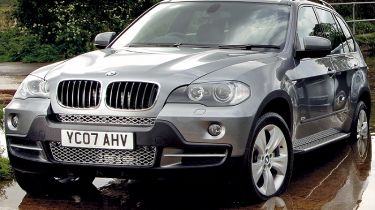BMW X5 (2006-2013) review
The latest X5 remains a fine car, with a welcome increase in practicality.

Driving
The X5 will easily sell best in 3.0d guise. The variant is predicted to claim more than 90 per cent of sales – so it’s fortunate the 3.0-litre six-cylinder unit is one of the world’s finest. Tweaked to produce 235bhp and 520Nm of torque, it’s far from slow, despite the X5’s hefty kerbweight. It’s eager and responsive, yet muffled, and is linked to a smooth and fast six-speed auto box. And even though the X5 has always traded on its performance, it’s good to know that the power is backed up by strong brakes and crisp, involving handling. With a stiff bodyshell and double wishbone front suspension, the BMW feels stable in corners and has great poise and traction. It’s nimble and wieldy. The ride is just as impressive. It has absorbent damping, despite the standard run-flat tyres, though it doesn’t steamroller bumps as well as it might. Stiff suspension settings mean you’re much more aware of what’s going on underneath the car – good for driver confidence, but not for comfort.
Marketplace
The latest X5 is an SAV, not an SUV. So says BMW, which insists its off-roader is a Sports Activity – rather than Utility – Vehicle. This seems like a minor point, but it highlights the fact that the German company is targeting a lifestyle audience rather than families alone. But while the BMW doesn’t quite offer the space and flexibility of opponents more biased towards practicality, enough has been done to improve matters without making the X5 appear too big or bulky. In fact, it appears smaller and more athletic than its predecessor, with sharp creases and a more aggressive nose. This gives it a visual edge over larger rivals such as the Audi Q7, Land Rover Freelander and Mercedes M-Class; indeed, this dynamic edge means it’s likely to battle particularly closely with the Range Rover Sport, not to mention Porsche’s Cayenne.
Owning
The X5 is not only BMW’s first seven-seater, but also boasts the firm’s largest luggage capacity – 1,750 litres with all the chairs folded flat. That sounds good until you compare this to some of the BMW’s rivals; it’s smaller than most of them, although people coming from the MkI X5 will be impressed by the capacity growth in 5st mode – from 465 to 620 litres. Furthermore, those extra seats are not only a £1,320 option, but are also small, hard and cramped. Adults shouldn’t even try to negotiate their way into them. At least all the handles that tilt and slide the middle row are chunky and easy to use, and the bench provides ample room for three. For the driver, the inside is a fusion of old and new X5 too, with an extra splash of user-friendliness. There are plenty of cubbies, a space-saving joystick-style gearlever and electric parking brake, and apart from the confusing iDrive cabin control dial, the switchgear is legible and logical. It just doesn’t feel that much like an off-roader; it’s luxurious rather than utilitarian, although the superb seats, which give a commanding view of the road, are welcome. So too is competitive fuel economy, certainly from the 3.0d. It returned 28.9mpg in our hands, meaning it should happily top 30mpg when driven gently. Retained values are predicted to be excellent as well – in excess of 55 per cent after three years – so it’s a shame BMW’s being greedy with the otherwise-excellent Service Inclusive scheme. £1,200 for three years’ cover is 10 times what the firm charges for a 1-Series.







